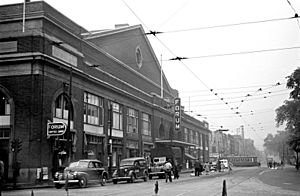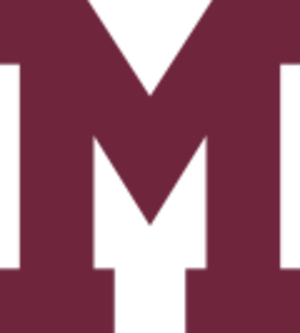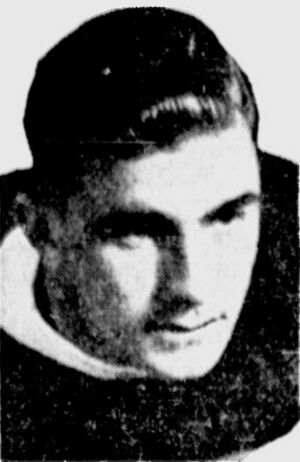Montreal Maroons facts for kids
Quick facts for kids Montreal Maroons |
|
|---|---|
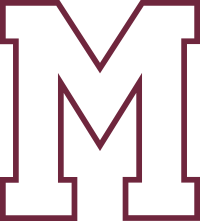 |
|
| Founded | 1924 |
| History | Montreal Maroons 1924–1938 (franchise cancelled 1947) |
| Home arena | Montreal Forum |
| City | Montreal, Quebec |
| Colours | Maroon, white |
| Stanley Cups | 1926 and 1935 |
| Conference championships | 1926, 1928, 1935 |
The Montreal Maroons were a professional ice hockey team in the National Hockey League (NHL). They played in the NHL from 1924 to 1938. The Maroons won the famous Stanley Cup twice, in 1926 and 1935. They were the last team outside the "Original Six" (the six teams that played in the NHL from 1942 to 1967) to win the Stanley Cup until the Philadelphia Flyers won in 1974.
The Maroons were created for the English-speaking community in Montreal. They shared their home city with the Canadiens, who were for the French Canadian population. Both teams eventually came under the same ownership. A new arena, the Montreal Forum, was built for the Maroons in 1924. The Maroons were a very strong team. They won the Stanley Cup twice and finished first in their division two other times. Many great players of that time played for the Maroons. Eleven players from the team were later chosen for the Hockey Hall of Fame.
The Great Depression caused money problems for the team. Because of this, the Maroons stopped playing after the 1938 season. Even though people tried to bring the team back, the franchise was officially ended in 1947. This left the Canadiens as the only hockey team in Montreal. Since the Maroons stopped playing, no other NHL team that has won a Stanley Cup has ever folded or moved to another city.
Contents
The Maroons' Story: A Hockey Journey
How the Maroons Started
The Montreal Maroons hockey team was formed to play for the English-speaking people of Montreal. Before this, on January 2, 1918, the Montreal Arena burned down. This arena was shared by the Montreal Canadiens and the Montreal Wanderers. The Canadiens, who mostly had French-speaking fans, moved to other arenas. The Wanderers, who were the English-speaking team, stopped playing.
By 1922, people started working to create a new team for the English-speaking community. They wanted this new team to join the NHL. In July 1924, construction began on a new arena. This arena was built where an old roller-skating rink used to be. It was called the Forum. By the fall, the Montreal Forum was finished. It cost $1.5 million to build. The Montreal Forum was the first large arena in the NHL.
The Maroons joined the NHL in 1924, at the same time as the Boston Bruins. The Canadiens at first did not want a second team in Montreal. But they agreed when they were paid money from the new team's expansion fee. Each new team paid $15,000 to join. The Canadiens received $11,000 of the Maroons' fee. The Canadiens' owner actually thought having a second team would create an exciting local rivalry.
When they first started, the Maroons did not have a nickname. The team's president, James Strachan, had owned the Wanderers before. He tried to get the Wanderers name for the new team, but it did not work out. So, the club was officially called the Montreal Professional Hockey Club. The team wore maroon-colored jerseys with a big letter "M" on them. The "M" stood for Montreal, not the color. But the media started calling them the "Maroons," and the name stuck. The club never officially changed its name to include "Maroons."
Early Success and Stanley Cup Wins
In their first season, the Maroons finished second to last in the league. However, the new Forum was always full of fans. With new players like Nels Stewart, Babe Siebert, and Bill Phillips, the team quickly became successful. In just one year, the Maroons went from having their worst record to their best.
In only their second season, Montreal won their first Stanley Cup. The NHL playoffs that year had a two-game series where the total goals scored decided the winner. Montreal won their first series against the Pittsburgh Pirates 6–4. Then, they surprised everyone by beating the favored Ottawa Senators 2–1. In the NHL playoff final, Montreal defeated Ottawa to move on to the Stanley Cup final. There, they played against the Victoria Cougars from the Western Hockey League. This was the last Stanley Cup final where two different leagues played each other. Montreal beat Victoria three games to one.
A rookie player, Nels Stewart, helped a lot in this victory. He scored six of the Maroons' ten goals in the series. Stewart later became a Hall of Famer. He also won the Hart Trophy for the league's most valuable player. Stewart was a big player for his time, standing six feet one inch tall and weighing 195 pounds. He was tough and scored many goals. His 34 goals as a rookie were an NHL record until the 1970–71 season. Back then, the best players often played the whole game, only leaving if they were injured.
For the 1926–27 season, the NHL grew to ten teams. It was divided into American and Canadian divisions. The Maroons finished third in the Canadian division, behind their rivals, the Canadiens. The two Montreal teams now shared the Forum. They met in the playoffs for a two-game series. The Forum was packed with 11,000 fans, even though its official capacity was 10,000. The Canadiens defeated the Maroons, who were the defending Stanley Cup champions. The Maroons also played in another important game. On November 26, 1926, they played against the New York Rangers in the Rangers' very first NHL game.
The Maroons got their revenge on the Canadiens in the 1927–28 season. They beat them in the playoff semi-finals. Then, the Maroons played the New York Rangers for the Stanley Cup. But they lost the series three games to two. All five games were played at the Forum because a circus was using Madison Square Garden.
The 1928–29 season was not good for the Maroons. They finished last in the Canadian division. However, they bounced back in the 1929–30 season and finished first. During these years, the Maroons had one of the most feared forward lines in the early NHL. It was called the "S Line." It included Hooley Smith, Babe Siebert, and Nels Stewart. This line was also known for getting many penalties.
In the 1929–30 season, Dunc Munro joined the team as a player-coach. During this season, Clint Benedict of the Maroons became the first goalie in NHL history to wear a mask. He wore it to protect a broken nose. Even though the Maroons finished first in their division, they lost in the first round of the playoffs to the Boston Bruins.
For the 1930–31 season, Stewart again led his team in goals and points. But the Maroons only finished third in the Canadian division. They were easily beaten in the first round of the playoffs by the New York Rangers.
The Maroons made it to the playoffs in the 1931–32 season. They finished five points ahead of the New York Americans. Montreal defeated Detroit in the first round. But they lost the semi-final game against the Toronto Maple Leafs.
The Maroons finished the 1932–33 season in second place in the Canadian division. They even had three of the top six players in league points. However, Montreal was eliminated in the first round of the playoffs by Detroit.
In the playoffs of the 1933–34 season, the Chicago Black Hawks beat both Montreal teams. They first defeated the Canadiens, then surprised the Maroons in the semi-finals.
In 1935, Leo Dandurand, who owned the Montreal Canadiens, sold his team. He sold it to Canadian Arena Company for $165,000. This company also owned the Montreal Maroons.
The Great Depression and the End of the Team
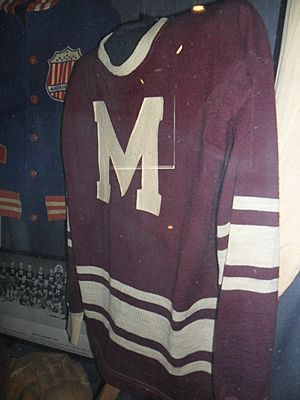
In Montreal, money problems from the Great Depression hurt how many people came to watch both the Canadiens and Maroons play. However, the Canadiens had many more French-speaking fans than the Maroons had English-speaking fans. Because of this, the Maroons had the lowest attendance in the league for three seasons in a row. Also, by 1935, both teams were owned by the same company, Canadian Arena Company. It became clear that Montreal could only support one hockey team. The Maroons' money troubles forced them to sell some of their players, including star winger Hooley Smith. Even with these problems, the Maroons continued to play good hockey into the 1930s.
For the 1934–35 season, the Maroons hired Tommy Gorman as coach. He had coached the Chicago Black Hawks to the championship the year before. The Maroons finished the season in second place behind Ottawa. In the playoffs, the Montreal Maroons beat Chicago by playing strong defense. They then beat the New York Rangers with an offensive style of play. After that, they defeated the Toronto Maple Leafs in three straight games. Gorman thought the Maple Leafs were one of the best hockey teams ever. The Maroons won their second Stanley Cup. Gorman is still the only coach in history to win back-to-back Stanley Cups with two different teams. The Maroons were the last team to win the Cup without losing a single playoff game for 17 years. Gorman called this Maroons team "the greatest team that ever stepped on the ice."
The playoffs of the 1935–36 season are famous for the longest NHL playoff game ever. On March 24–25, the Maroons lost 1–0 to the Detroit Red Wings. The game lasted 176 minutes and 30 seconds, going into the sixth overtime period. This game was very important for Detroit goalie Normie Smith, who had started his career with the Maroons. He shut out the Maroons again in the second game. This allowed Detroit to win the series in three games, letting in only one goal. Detroit then went on to win their first Stanley Cup.
In December 1936, Maroons captain Hooley Smith was traded to the Boston Bruins. This trade marked the beginning of the end for the team. In the 1936–37 season, Nels Stewart broke Howie Morenz's record for career goals with 271. Stewart held the all-time career goal record until Maurice Richard broke it in 1952.
By the start of the 1937–38 season, rumors were common that the Maroons would move to another city. In September 1937, Maroons president Donat Raymond said the team would stay in Montreal. But the team's bad money situation finally caught up with them. They finished with a record of 12 wins, 30 losses, and 6 ties. This was the team's worst season since 1924–25. Lionel Conacher retired before the season to go into politics. He won a seat in the 1937 Ontario general election as a member of the Liberal Party. Tommy Gorman had tried to get Conacher to stay and become coach. His retirement led Gorman to hire King Clancy. Clancy did not help the team's record. On December 29, he was fired after 18 games, and Gorman became coach again. The Maroons' last game was a 6-3 loss to the Canadiens on March 17. They finished the season last in their division and last in the league.
At the annual league meeting on June 22, the Maroons formally asked the league to let them stop playing for a year. This was not allowed. The league asked the Maroons to confirm by August 1 if they would play in the next season.
The league eventually allowed the Maroons to stop playing for the 1938–39 season. Even though it wasn't called a merger, it looked like the two Montreal teams were combining. The Montreal owners were allowed to keep the NHL rights to the Maroons' players. However, the owners had already seen the Maroons as Montreal's second team. They had already moved many of their best players, like future Hall of Famer Toe Blake, to the Canadiens. Because of this, only a few Maroons players played for the Canadiens in the 1938–39 season. Most of the Maroons players were either sold to other NHL teams for money or left the league completely.
Attempts to Bring the Team Back
The Maroons' owners tried to sell their team to people in St. Louis, Missouri. But the league said no. This was because of doubts about the earlier failure of the St. Louis Eagles team. At the 1945 annual league meeting, it was noted that the Maroons' owners were talking about selling the team to a group from Philadelphia. This group was led by Len Peto, a Canadiens board member. The league was ready to approve the move. But the Philadelphia group had to prove they had enough money for a hockey team. The league also made it clear that the Maroons' team rights would end in April 1947 if nothing was done with them.
Peto was able to get the money needed. He convinced the league to move the Maroons to Philadelphia. However, Philadelphia did not have an arena big enough for an NHL team. The city's largest arena, the Palestra, did not have an ice plant. Both the University of Pennsylvania and Madison Square Garden (who managed the Palestra) did not want to pay to install one. The only arena with an ice plant, Philadelphia Arena, was too small and had bad views. The league gave Peto until the end of the 1946–47 season to find a suitable arena. In February 1946, Peto announced plans to build a 20,000-seat arena. It would cost $2.5 million. But his group could not get the money for the project by the deadline. So, the NHL officially ended the Maroons franchise.
The last player from the Maroons to play in the NHL was Herb Cain. He played until 1946.
Maroons' Season Records
Note: GP = Games played, W = Wins, L = Losses, T = Ties, Pts = Points, GF = Goals for, GA = Goals against, PIM = Penalties in minutes
| Season | GP | W | L | T | Pts | GF | GA | PIM | Finish | Playoffs |
|---|---|---|---|---|---|---|---|---|---|---|
| 1924–25 | 30 | 9 | 19 | 2 | 20 | 45 | 65 | 264 | fifth, NHL | Did not make playoffs |
| 1925–26 | 36 | 20 | 11 | 5 | 45 | 91 | 73 | 554 | second, NHL | Won Semifinals (Pittsburgh) Won Finals (Ottawa) Won Stanley Cup (Victoria) |
| 1926–27 | 44 | 20 | 20 | 4 | 44 | 71 | 68 | 716 | third, Canadian | Lost Quarterfinals (Montreal) |
| 1927–28 | 44 | 24 | 14 | 6 | 54 | 96 | 77 | 549 | second, Canadian | Won Quarterfinals (Ottawa) Won Semifinals (Montreal) Lost Finals (NY Rangers) |
| 1928–29 | 44 | 15 | 20 | 9 | 39 | 67 | 65 | 638 | fifth, Canadian | Did not make playoffs |
| 1929–30 | 44 | 23 | 16 | 5 | 51 | 141 | 114 | 651 | first, Canadian | Lost Semifinals (Boston) |
| 1930–31 | 44 | 20 | 18 | 6 | 46 | 105 | 106 | 568 | third, Canadian | Lost Quarterfinals (NY Rangers) |
| 1931–32 | 48 | 19 | 22 | 7 | 45 | 142 | 139 | 593 | third, Canadian | Won Quarterfinals (Detroit) Lost Semifinals (Toronto) |
| 1932–33 | 48 | 22 | 20 | 6 | 50 | 135 | 119 | 442 | second, Canadian | Lost Quarterfinals (Detroit) |
| 1933–34 | 48 | 19 | 18 | 11 | 49 | 117 | 122 | 414 | third, Canadian | Won Quarterfinals (NY Rangers) Lost Semifinals (Chicago) |
| 1934–35 | 48 | 24 | 19 | 5 | 53 | 123 | 92 | 380 | second, Canadian | Won Quarterfinals (Chicago) Won Semifinals (NY Rangers) Won Stanley Cup (Toronto) |
| 1935–36 | 48 | 22 | 16 | 10 | 54 | 114 | 106 | 504 | first, Canadian | Lost Semifinals (Detroit) |
| 1936–37 | 48 | 22 | 17 | 9 | 53 | 126 | 110 | 379 | second, Canadian | Won Quarterfinals (Boston) Lost Semifinals (NY Rangers) |
| 1937–38 | 48 | 12 | 30 | 6 | 30 | 101 | 149 | 470 | fourth, Canadian | Did not make playoffs |
| Totals | 622 | 271 | 260 | 91 | 633 | 1474 | 1405 | 7122 |
Team Leaders: Captains and Hall of Famers
Team Captains
- Punch Broadbent 1924–25
- Dunc Munro 1925–28
- Nels Stewart 1928–32
- Hooley Smith 1932–36
- Lionel Conacher 1936–37
- Stewart Evans 1937–38
Hockey Hall of Fame Players
Many players who played for the Montreal Maroons later became members of the Hockey Hall of Fame. This shows how talented the team was.
| Name | Year Inducted |
|---|---|
| Clint Benedict | 1965 |
| Toe Blake | 1966 |
| Georges Boucher | 1960 |
| Punch Broadbent | 1962 |
| King Clancy | 1958 |
| Sprague Cleghorn | 1958 |
| Lionel Conacher | 1994 |
| Alec Connell | 1958 |
| Red Dutton | 1958 |
| Eddie Gerard | 1945 |
| Reg Noble | 1962 |
| Babe Siebert | 1964 |
| Hooley Smith | 1972 |
| Nels Stewart | 1952 |
Hockey Hall of Fame Builders
These people helped build and manage the Montreal Maroons team.
| Name | Year Inducted |
|---|---|
| Tommy Gorman | 1963 |
| William Northey | 1947 |
| Donat Raymond | 1958 |
| Carl Voss | 1974 |
Awards Won by Maroons Players
| Player | Award | Year |
|---|---|---|
| Russ Blinco | Calder Memorial Trophy | 1934 |
| Nels Stewart | Hart Memorial Trophy | 1926, 1930 |
Home Arena
- Montreal Forum — This arena was built especially for the Maroons. The Forum later became one of the most famous hockey arenas because of the Canadiens. They shared the arena with the Maroons from 1926 to 1938.
More About the Maroons
- List of Montreal Maroons players
- List of Montreal Maroons head coaches
- List of Stanley Cup champions
- Montreal Wanderers
- Montreal Canadiens
- List of NHL teams that no longer exist
- List of NHL seasons
See also
 In Spanish: Montreal Maroons para niños
In Spanish: Montreal Maroons para niños


